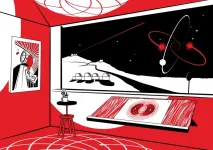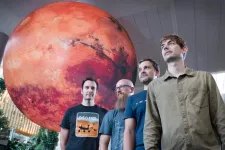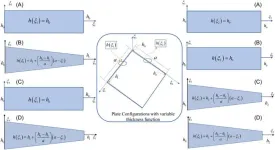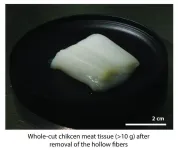(Press-News.org) ANN ARBOR—Ancient Homo sapiens may have benefitted from sunscreen, tailored clothes and the use of caves during the shifting of the magnetic North Pole over Europe about 41,000 years ago, new University of Michigan research shows.
These technologies could have protected Homo sapiens living in Europe from harmful solar radiation. Neanderthals, on the other hand, appear to have lacked these technologies and disappeared around 40,000 years ago, according to the study, published in Science Advances and led by researchers at Michigan Engineering and the U-M Department of Anthropology.
The team found that the North Pole wandered over Europe when the magnetic field's poles started to flip positions, a natural process that has happened around 180 times over Earth's geological history. While the magnetic reversal didn't complete at the time, the magnetic field weakened to cause aurora to occur over most of the globe, and allowed more harmful UV light to come in from space.
Around the same time, Homo sapiens appear to have started making tailored clothing and using ochre, a mineral that has sun-protective properties when applied to the skin, with greater frequency. These behaviors could have contributed to their spread throughout Europe and Asia at a time when the Neanderthal population was declining.
"In the study, we combined all of the regions where the magnetic field would not have been connected, allowing cosmic radiation, or any kind of energetic particles from the sun, to seep all the way in to the ground," said Agnit Mukhopadhyay, lead author and U-M research affiliate in climate and space sciences and engineering.
"We found that many of those regions actually match pretty closely with early human activity from 41,000 years ago, specifically an increase in the use of caves and an increase in the use of prehistoric sunscreen."
Wandering poles
Earth's magnetic field is created by its rotation, and by extension, the rotation of its core. The core, which is composed of molten iron, generates electrical currents, which extend in a halo around the globe. This halo helps protect Earth from cosmic radiation—the stuff that thins Earth's ozone layer and lets in more UV light. The interaction of these particles with Earth's magnetic field results in aurora as well.
Mukhopadhyay began building models of this interaction using the Space Weather Modeling Framework, a versatile numerical tool developed and maintained by the U-M Center for Space Environment Modeling, to study the sun, heliosphere and planetary space environments, including that of Earth.
The sun continually throws hot gases and charged particles toward Earth, which, because of their extremely high temperatures, act as a plasma system. Mukhopadhyay developed a model that predicts how this plasma system interacts with Earth's magnetic field, ultimately driving the formation of the aurora.
This magnetic field has a north and south orientation: the North and South poles. The orientation of the magnetic field is why you typically only see aurora at the North and South poles, where magnetic fields are the strongest. But occasionally throughout history, these poles wander from their traditional geographic positions. These are called "geomagnetic excursions," says Mukhopadhyay. The most recent event is called the Laschamps excursion, which occurred about 41,000 years ago.
Working with Sanja Panovska, a researcher at Germany's GFZ Helmholtz Centre for Geosciences, Mukhopadhyay created a 3D reconstruction of Earth's geospace system. To do this, the researchers combined three separate models: one global model that reconstructs the geomagnetic field during the Laschamps excursion, a model of the space plasma environment around Earth, and a model that predicted what Earth's aurora looked like at the time. The resulting 3D model showed where charged particles were able to slip through Earth's geomagnetic field.
The researchers found that during the Laschamps excursion, Earth's magnetic field reduced in size to about 10% of its current strength. This allowed Earth's magnetic poles to droop down near the equator and for its magnetic field lines to expand. This would have also allowed aurora to be seen all over Europe and into northern Africa.
The researchers then laid their 3D map of Earth's space system over the world, and found that the time period of the Laschamps excursion—which lasted from about 41,000 to 39,000 BP—coincided with periods of change for groups of humans living on the planet
Cosmic rays, radiation and survival
Neanderthals and Homo sapiens coexisted in Europe, with Homo sapiens—often called anatomically modern humans—arriving roughly 56,000 years ago, says Raven Garvey, U-M associate professor of anthropology. By about 40,000 years ago, Neanderthals were no longer identified as a species in Europe.
"What some of the differences are between these species, between Neanderthals and anatomically modern humans, that might account for that disappearance has been a major anthropological question for decades," Garvey said.
Clothing may have been a contributing factor, she said. The technological means of producing clothing that fitted to the body has been discovered at archaeological sites associated with anatomically modern humans, but not necessarily Neanderthals.
However, at sites associated with anatomically modern humans, archaeologists have found not only scrapers used in hide production, but also needles and awls—items associated with sewing. According to Garvey, tailored clothing has a twofold benefit: It was significantly warmer and the added warmth meant that people could travel farther from their hearths and shelters in search of food.
Tailored clothing could have also provided another unintended benefit—protection from sun damage, she said.
There are multiple detrimental effects of solar radiation, including ocular pathologies and folate depletion (which can lead to birth defects and increased infant mortality), "so having protection against solar radiation would also have conferred significant advantage to anyone who possessed it," Garvey said.
Homo sapiens may have also ramped up their use of ochre, a naturally occurring pigment composed of iron oxide, clay and silica that has been used by many species of hominins for a very long time. People used it to paint objects, cave walls and even to decorate their bodies.
"There have been some experimental tests that show it has sunscreen-like properties. It's a pretty effective sunscreen, and there are also ethnographic populations that have used it primarily for that purpose," Garvey said. "Its increased production and its association primarily with anatomically modern humans (during the Laschamps) is also suggestive of people's having used it for this purpose as well."
Finding caution in the (solar) wind
The researchers are careful to underscore that their findings aren't definitive. However, they are a new way to look at already existing data.
"I think it's important to note that these findings are correlational and (ours is a) meta analysis, if you will," Garvey said. "But I think it is a fresh perspective on these data in light of the Laschamps excursion."
In addition to examining how previous excursions might have affected humans long ago, Mukhopadhyay said the 3D model offers people a way to predict how excursions might affect us in the future.
"If such an event were to happen today, we would see a complete blackout in several different sectors," he said. "Our communication satellites would not work. Many of our telecommunication arrays, which are on the ground, would be severely affected by the smallest of space weather events, not to mention the human impacts which would also play a pretty massive role in our day-to-day lives."
Mukhopadhyay also pointed out that their work also highlights that people were still able to survive on a planet whose atmosphere looked a lot different than ours does today, and this has implications for the search for life on planets other than Earth.
"Many people say that a planet cannot sustain life without a strong magnetic field," he said. "Looking at prehistoric Earth, and especially at events like this, helps us study exoplanetary physics from a very different vantage point. Life did exist back then. But it was a little bit different than it is today."
Study co-authors also include Michael Liemohn, Daniel Welling and Austin Brenner of Michigan Engineering, Natalia Ganjushkina of both Michigan Engineering and the Finnish Meteorological Institute, Ilya Usoskin of the University of Oulu and Mikhail Balikhin of the University of Sheffield.
END
Sunscreen, clothes and caves may have helped Homo sapiens survive 41,000 years ago
2025-04-16
ELSE PRESS RELEASES FROM THIS DATE:
"Big surprise": astronomers find planet in perpendicular orbit around pair of stars
2025-04-16
Astronomers have found a planet that orbits at an angle of 90 degrees around a rare pair of peculiar stars. This is the first time we have strong evidence for one of these ‘polar planets’ orbiting a stellar pair. The surprise discovery was made using the European Southern Observatory’s Very Large Telescope (VLT).
Several planets orbiting two stars at once, like the fictional Star Wars world Tatooine, have been discovered in the past years. These planets typically occupy orbits that roughly align with the plane in which their host stars orbit each ...
Astronomers find rare twist in exoplanet’s twin star orbit
2025-04-16
Astronomers have discovered a planet that orbits at a 90-degree angle around a rare pair of strange stars – a real-life ‘twist’ on the fictional twin suns of Star Wars hero Luke Skywalker’s home planet of Tatooine.
The exoplanet, named 2M1510 (AB) b, orbits a pair of young brown dwarfs — objects bigger than gas-giant planets but too small to be proper stars. Only the second pair of eclipsing brown dwarfs known – this is the first exoplanet found on a right-angled path to the orbit of its two host stars.
An international team of researchers led ...
Crystal clues on Mars point to watery and possibly life-supporting past
2025-04-16
A QUT-led study analysing data from NASA’s Perseverance rover has uncovered compelling evidence of multiple mineral-forming events just beneath the Martian surface – findings that bring scientists one step closer to answering the profound question: did life ever exist on Mars?
The QUT research team led by Dr Michael Jones, from the Central Analytical Research Facility and the School of Chemistry and Physics, includes Associate Professor David Flannery, Associate Professor Christoph Schrank, Brendan Orenstein and Peter Nemere, together with researchers from North America and Europe.
The findings were published in the prestigious journal ...
Microbes in Brooklyn Superfund site teach lessons on fighting industrial pollution
2025-04-16
Using advanced DNA sequence analysis, a research team led by NYU Tandon School of Engineering's Assistant Professor Elizabeth Hénaff has discovered that tiny organisms in Brooklyn's highly contaminated Gowanus Canal have developed a comprehensive collection of pollution-fighting genes.
The findings were published in the Journal of Applied Microbiology on April 15, 2025.
The team identified 455 species of microorganisms wielding 64 different biochemical pathways to degrade pollutants ...
Porous and powerful: How multidirectional grading enhances piezoelectric plate performance
2025-04-16
Piezoelectric materials have long been celebrated for their ability to convert mechanical energy into electrical energy, making them indispensable in smart systems for sensing, actuation, and vibration control. However, incorporating porosity and multidirectional grading into these materials introduces a host of challenges in understanding their behavior under varying environmental conditions. These complexities are further compounded by the interaction of hygrothermal conditions with electrical and mechanical loads. As a result, there is a pressing need for more in-depth research to predict the real-world performance of these materials.
Published ...
Study finds dramatic boost in air quality from electrifying railways
2025-04-16
Switching from diesel to electric trains dramatically improved the air quality aboard the San Francisco Bay Area’s Caltrain commuter rail line, reducing riders’ exposure to the carcinogen black carbon by an average of 89%, finds a new study published today in the journal Environmental Science and Technology Letters.
The electrification of the system also significantly reduced the ambient black carbon concentrations within and around the San Francisco station, the study found.
“The transition from diesel to electric trains occurred over just a few weeks, and yet we saw the same drop in black carbon concentrations in the station as California ...
Bite-sized chunks of chicken with the texture of whole meat can be grown in the lab
2025-04-16
A bioreactor that mimics a circulatory system can deliver nutrients and oxygen to artificial tissue, enabling the production of over 10 grams of chicken muscle for cultured meat applications. These results are publishing in the Cell Press journal Trends in Biotechnology on April 16.
“Our study presents a scalable, top-down strategy for producing whole-cut cultured meat using a perfusable hollow fiber bioreactor,” says senior author Shoji Takeuchi of The University of Tokyo. “This system enables cell distribution, alignment, contractility, ...
A compact, mid-infrared pulse generator
2025-04-16
Physicists in the Harvard John A. Paulson School of Engineering and Applied Sciences (SEAS) have created a compact laser that emits extremely bright, short pulses of light in a useful but difficult-to-achieve wavelength range, packing the performance of larger photonic devices onto a single chip.
Published in Nature, the research is the first demonstration of an on-chip, picosecond, mid-infrared laser pulse generator that requires no external components to operate. The device can make what’s called an optical frequency comb, a spectrum of light consisting of equally spaced frequency lines (like a comb), used today in precision measurements. ...
Sex-based differences in binge and heavy drinking among US adults
2025-04-16
About The Study: This analysis found that past-month binge drinking among young adult females in 2021-2023 was higher than males, reversing 2017-2019 patterns, whereas males in other age groups continued to binge and heavy drink at higher rates. These findings may be due to more rapid decreases in binge drinking over time among young adult males relative to females, or to plateauing or increases in binge drinking among females. Further investigation using other nationally representative surveys is needed to elucidate these explanations.
Corresponding Author: To contact the corresponding author, Bryant Shuey, MD, MPH, email bryant.shuey@pitt.edu.
To ...
Using vibrations to see into Yellowstone's magma reservoir
2025-04-16
Beneath Yellowstone lies a magma reservoir, pulsing with molten and superheated rock and exsolved gases. Scientists have long known about the chamber’s existence, but have yet to precisely locate its uppermost boundary and characterize the contents of the chamber closest to the surface—information crucial for understanding the potential perils this volcanic feature poses.
That changed this week with new research by seismologists from the University of Utah and the University of New Mexico (UNM) who used hundreds of portable seismometers and a mechanical vibration source to render 2D seismic reflection images of the ground beneath Yellowstone’s caldera.
Using ...






